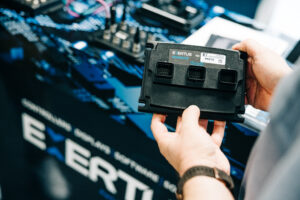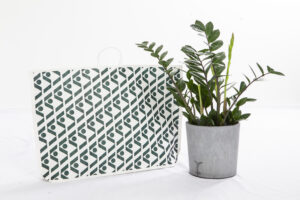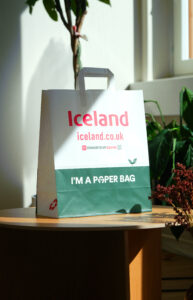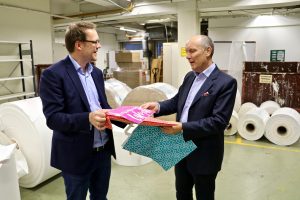-
Services
-
The exhibition booth of Exertus Oy from Seinäjoki drew a steady stream of visitors at this year’s Bauma trade fair in Munich, as the manufacturer of control systems for mobile machinery introduced itself to potential customers. According to Sami Takaneva, Exertus’ Head of Marketing and Communications, the attention the company received at the world’s largest construction machinery trade fair was many times greater than in previous years. This was partly due to the booth’s renewed appearance.
“Updating the company logo and all marketing communications was a worthwhile investment. Clarifying the brand supports our growth leap in international markets,” Takaneva says.
Exertus develops and provides control systems, as well as related software and components, for sectors such as earthmoving, mining, forestry, and specialty vehicles. Their solutions include vehicle control, hydraulic management, user interfaces, and machine safety systems.
“An intelligent control system is the brain of a machine. Our solutions are suited to applications where reliable performance, durability, and ease of integration are essential.”
Exertus’ customer base includes both domestic and international machinery manufacturers. One such client is Normet, with whom Exertus has developed control solutions for underground vehicles and spraying equipment.
In consumer markets, a company’s brand is everything—but according to Takaneva, it is also crucial for an industrial subcontractor.
“For us, the Exertus brand is a symbol of trust and credibility. Our products and services are often part of customers’ critical systems, where quality and performance are of utmost importance. When a customer sees the Exertus name on a device or software, it signals a safe, tested, and reliable solution,” Takaneva explains.
As part of the brand renewal, the company registered the Exertus® trademark in its key markets. In addition, Exertus uses product-specific brand names, which are protected as necessary.
“Trademark protection helps prevent misuse of our name without permission or with compromised quality.”
Takaneva notes that protecting trademarks also supports long-term customer relationships, as it ensures continuity and a consistently developing product range.
“The value of the Exertus brand doesn’t come just from visibility—it stems from its ongoing representation of quality and expertise.”
In managing trademarks, Exertus works closely with Laine IP.
Exertus brings a business-driven perspective to trademark management—what the company wants to protect, why, and in which markets. Laine IP, in turn, acts as an expert partner in both strategic planning and practical execution.
“Laine IP is responsible for tasks such as drafting applications, handling official procedures, and monitoring and enforcement,” Takaneva says.
He emphasizes that the collaboration is built on continuous dialogue.
“Laine IP brings the legal expertise. We define the commercial goals. The division of work functions well—allowing us to focus on product and brand development, while Laine IP ensures protection is carried out effectively and correctly.”
According to Takaneva, a successful partnership with an IP law firm is based above all on trust, expertise, and an understanding of business needs.
“It’s important to us that our IPR partner can look at things not only from a legal but also a strategic perspective: what’s worth protecting, to what extent, and in which regions. A good partner also dares to ask questions, suggest solutions, and challenge when needed.”
Takaneva expects the IP law firm to communicate clearly, respond quickly, and translate even complex legal matters into business-relevant insights.
“Laine IP has met these expectations excellently. Their expertise and experience are evident in how smoothly and proactively they operate in various situations—whether it’s trademarks, contracts, or international protection.”
“This kind of partnership provides peace of mind and lets us focus on our core competencies. We know our IPR matters are in good hands,” Takaneva emphasizes.
In addition to trademarks, Exertus has carefully considered the protection of other intellectual property rights. The goal of the company’s IPR strategy is to safeguard both its own and its customers’ competitiveness—and ensure that developed solutions retain their value well into the future.
“Our key IPR concerns involve copyrights related to software and electronic design, as well as trademark protection. In terms of patents, we mainly focus on customer-specific solutions, where ownership of innovations is defined on a project basis.”
“We also have proprietary technology, the uniqueness of which we protect either through technical means, such as closed software architectures, or—when needed—via formal IPR methods.”

Exertus, part of the Swedish Dacke Industri Group, has an annual turnover of around 10 million euros. The Ostrobothnia region is home to many similarly innovative technology companies. According to Takaneva, businesses operating in international markets have already recognized the importance of IPR matters quite well.
“Still, there’s untapped potential.”
Takaneva has observed that the benefits of trademarks and other IPR rights are often viewed too narrowly—limited to technical protection or legal obligations. IPRs may not yet be seen as strategic tools for brand building, market positioning, or securing customer relationships.
“For companies like Exertus, this offers an opportunity to share expertise and raise awareness of how IPR protection can genuinely support growth and internationalization in a cost-effective and sustainable way.”
Text: Matti Remes
Photos: Exertus Oy
The growth of Paptic, a developer of materials that replace plastic, is supported by a carefully built IPR portfolio. In matters of patents and trademarks, Laine IP has been a key partner for the company since its inception.
At Sokos and Stockmann, customers’ clothing purchases are packed not in plastic or paper bags, but in shopping bags made of a material that feels soft and textile-like. These are made using a Finnish manufacturing method developed by Paptic, which produces durable, strong, and recyclable packaging materials as alternatives to plastic.

Esa Torniainen, Paptic’s Chief Development Officer and one of its founders, says that Paptic material combines the best qualities of paper, plastic, and fabric. The innovation, based on development work done at VTT Technical Research Centre of Finland, enables the production of fiber-based products from softwood pulp in a way that conserves both energy and water.
“There are two parts to the Paptic innovation. The first is the recipe—an innovative combination of raw materials that results in a functional and recyclable material. The second part is foam-forming technology. It’s not yet in use, but we’re preparing to scale it,” says Torniainen.
Currently, Paptic’s materials are produced by three contract manufacturers in Europe, using traditional papermaking technology along with Paptic’s recipes and expertise.
In addition to shopping bags, Paptic’s materials are used to package food products, cosmetics, and consumer electronics. They’re also used for packaging toys, leather goods, and tools.
Torniainen emphasizes that Paptic is not a single product, but a family of products designed for different applications. The company aims to comprehensively protect its manufacturing technology and products to ensure freedom to operate in international markets. Strong IPR protection is also crucial for enabling future licensing of the technology to other manufacturers.
“We seek patents and trademarks in a broad and global manner. Of course, we always carefully evaluate what kind of protection is reasonable and cost-effective,” says Torniainen.

Currently, Paptic has nearly 10 patent families for its products and production methods. In addition to registering the Paptic name as a trademark, the company has trademarked the names of each of its four product families. It has also applied for trademarks for products not yet on the market.
“When it comes to IPR, it’s essential to understand what and where to protect. But it’s at least as important to consider how we should go about protecting things. In these discussions, we place great value on Laine IP’s strong expertise,” says Torniainen.
Laine IP became Paptic’s IPR partner when the company was founded in 2015.
Torniainen believes that for a startup, it’s crucial to find a reliable partner for patents and trademarks—one who is ready to start building cooperation even when the business is still in its early stages.
“An IPR partner must also believe in the startup’s potential. We value the fact that Laine IP has taken the time to thoroughly understand our innovations and our business.”
Torniainen expects more than just technical patent application writing and trademark registration from a patent office. He has come to appreciate Laine IP’s strategic and consultative approach.
“Patents and trademarks are not just about protecting technology and products; they’re also a major part of business development. A good IPR partner dares to challenge us and offer their own suggestions. That’s valuable to us, as we are innovators, not IPR experts.”
According to Torniainen, a credible and well-constructed IPR portfolio and strategy are becoming increasingly important for Paptic as the company grows. They are of interest not only to investors, but also to larger clients looking for long-term partnerships.
“A carefully considered IPR strategy is also important for us internally. It supports us as we steer the business and develop new solutions.”
Torniainen notes that one of the key challenges for a startup is constant change. That’s why the IPR strategy, patents, and trademarks must be designed not only for current protection, but also to meet future needs.
Paptic’s growth is driven by a global megatrend seeking alternatives to plastic. In many countries, for example, the use of plastic bags is restricted, and there is a move toward packaging made from renewable materials.

Paptic’s solution first gained traction in shopping bags. In addition to Sokos and Stockmann, reusable bags made from Paptic’s material have been tested at a few K-Supermarkets in Finland. The bags are also used by Luhta and by Moomin Characters, known for Moomin products, which is also a shareholder in Paptic.
Among international customers, one of the largest is the UK retail chain Iceland. According to Torniainen, Paptic’s main focus is on international markets, which already account for the majority of the company’s revenue—€7 million in 2023.
Text: Matti Remes
Photos: Paptic Oy
Paptic Oy has developed an alternative to plastic bags and packaging. A carefully managed patent portfolio creates a strong base for the growth of this startup company.
Reducing the use of plastics along with their environmental impact is a global effort that is gaining ground rapidly. Finland-based Paptic Oy has developed a wood-based material that can replace plastic, while combining the best properties of paper, plastic and fabric.
Paptic CEO and founder Tuomas Mustonen says the soft and textile-like product can aptly be called “paper fabric”.
“The key point about using a wood-based material is that a bag made from this material can be used multiple times – and it is also fully recyclable,” Mustonen notes.
Paptic’s revolutionary innovation has a solid scientific background. The product is based on years of research into foam forming at VTT Technical Research Centre of Finland. Foam forming technology enables the manufacturing of fiber-based products from pine or fir pulp in a highly efficient process that also helps conserve energy and water.
Packaging and the use of plastics are undergoing a major transformation around the world. For example, in many European countries the use of plastic bags is being limited, or consumers now need to pay for them.
“Shoppers are steering their habits into a more eco-friendly direction. People are increasingly aware of the environmental problems caused by plastics,” says Mustonen.
Paptic’s shopping bags have already been tested in stores. Potential customers include fashion, cosmetics and sporting goods chains that want to differentiate themselves with ecological, durable shopping bags.

Tuomas and Christoffer examine the paper fabric. / Photo: Matti Remes
The material has also attracted strong attention internationally. For example, renowned French retail chain Galeries Lafayette uses Paptic’s shopping bags.
“Another application for our material is shipping envelopes for online sellers, which are currently made of plastic.”
Paptic is getting ready to ramp up its production to full industrial scale. According to Mustonen, this will be accomplished by converting an existing paper machine to produce the Paptic material.
“We are currently in negotiations with several partners, and expect the investment to be completed in 2020.”
Seppo Laine’s patent attorney Christoffer Sundman has followed Paptic’s journey closely, since he has helped the company draft its patent applications.
“As a patent attorney, it’s great to work with startup companies, since it gives an opportunity to really get into the technology and business of the client. One gets to know both sides of the company, and can see the connection between them,” Sundman says.
Paptic currently has five patents or pending patent applications for its products. Tuomas Mustonen notes that for all of the patents, the actual invention has developed to its final form during the patenting process. “Paptic is not a single product, but a material and product family. For this reason, our goal has been to protect the manufacturing technology and our products as comprehensively as possible.”
Mustonen is very happy with the coaching and consulting from Seppo Laine.
“We have collaborated with Seppo Laine Oy for a long time now, and we know that they have the top expertise in this field of technology. I also greatly value their strategic approach; it’s not only about protecting technology, but most of all about developing our future business.”
Mustonen says that for a startup such as Paptic, protecting the company’s technology is crucial. A well-managed IP portfolio enables even a small company to compete on an equal footing with major industry players.
“Protecting our own technology gives us the freedom to operate in our markets. In particular, our long-term goal is to license our technology alongside our own manufacturing operations. This means that we need strong protection for our IPR,” says Mustonen.
Christoffer Sundman is happy to bring his long IPR experience to support Paptic’s business growth. The collaboration has been a successful one on all counts.
“The best thing about this cooperation is the opportunity to work with such creative, energetic and passionate people,” says Sundman. “They approach their work with a can-do attitude that radiates to everyone around them. It has been great to see Paptic succeed in their demanding and competitive industry.”
Text: Matti Remes
At the University of Helsinki, Professor Ilkka Kilpeläinen is leading research into new types of solvents that enable the manufacturing of textiles from pulp as well as replace the plastics in cleaning products with biodegradable microbeads. The latest application is the ability to glue wood – without using glue.
Ilkka Kilpeläinen is Professor of Organic Chemistry at the University of Helsinki. He is shown holding up a set of small glass vials, which contain what appear to be tiny plastic granules. However, the beads are not made of plastic, but of cellulose.
In the future, these biodegradable grains could supplant the plastic microbeads that are currently used in products such as toothpastes and detergents. The environmental impact of plastic microbeads from wastewater being carried into rivers and lakes has raised significant concern among researchers in recent years.
The new biodegradable microbeads are just one application of a new method for dissolving cellulose that has been developed at the Department of Chemistry of the University of Helsinki. The process allows cellulose fibers to be dissolved efficiently and non-toxically by utilizing a new type of ionic liquid solvent. The method is highly flexible, as it allows the use of diverse raw materials ranging from cellulose to recycled paper and discarded clothing.
“The solvents that we have developed are organic salts with a unique set of properties. For example, they are fully recyclable and non-toxic,” Prof. Kilpeläinen says.
The first application of the process was an eco-friendly method for manufacturing textile fibers, developed in collaboration with Aalto University. The result of the research was the Ioncell process that can be used to replace cotton or viscose. Viscose requires highly toxic carbon disulfide when it is manufactured from cellulose.
“From the beginning, our goal was to create a fiber material that was as high-quality as possible. In its tensile strength properties, Ioncell is on a par with hemp, so it’s really strong.”
The University of Helsinki has collaborated with Aalto University and the forest industry on the project. So far, production of the fiber has been limited, but in the next few years, the new material may progress to manufacturing on a commercial scale. The first company to try out the new invention was Finnish design house Marimekko, which unveiled a print-patterned dress made from Ioncell fabric in 2014.
The Ioncell process has many more practical applications, such as the manufacture of cellulose-based materials that are extremely lightweight. Small cellulose balls can be made highly porous, thus trapping air inside the material.
“A cubic meter of this kind of material only weighs about 30 kilograms, and due to the large amount of air contained in its pores, it has great insulating properties. The material could potentially replace styrofoam packing,” Kilpeläinen says.
The latest Ioncell application is using the ionic solvent to join pieces of wood together. “It’s kind of like gluing wood without glue. One could describe it as chemical welding for wood,” explains Kilpeläinen.
The method involves applying a small amount of the solvent on the wood surfaces to be joined. The parts are then pressed together and the used solvent is removed. The solvent dissolves the cellulose and lignin in the joint area, and the parts are fused together upon drying. The joint is so tight that it is difficult to discern even with an electron microscope.
“During heating, the solvent evaporates, so it can be collected for reuse,” Kilpeläinen explains. He notes that ionic solvents for cellulose are widely known, so it’s surprising that no one had thought of trying to ‘glue’ wood with them. “Because it works like a charm!”
Kilpeläinen expects a host of other applications to be discovered for the versatile Ioncell process. “The biggest challenge is actually the difficulty of choosing where to focus the research.”
The University of Helsinki and Aalto University have applied for approximately a dozen patents for the Ioncell process and its related products. The universities also hold joint patents.
“Our patent portfolio is shaping up to be pretty substantial, all the way from the solvents to the manufacturing processes and end products,” says Kilpeläinen. When applying for patents for Ioncell products and processes, the University of Helsinki has had the support of Seppo Laine Oy’s patent expertise.
“Seppo Laine’s patent attorneys are skilled in constructing strong patent applications, and the collaboration has been very smooth in every way,” says Professor Kilpeläinen.
Text: Matti Remes
After years of hard work, Finnish company Nordic Koivu has succeeded in turning a unique natural material – birch sap – into an export product with global potential. The company’s production of birch sap is set to multiply over the next few years.
Based in Tohmajärvi, Northern Carelia, Nordic Koivu Oy is working hard to boost the production volumes of birch sap to a completely new level. The company is expanding what is already the largest sap factory in the world, and is actively looking for new birch woods that could be used to harvest the sap.
“For several years, we have been working on some big customer cases that have now come through, and we need to answer the fast-growing demand,” says Nordic Koivu entrepreneur Susanna Maaranen.
With customers in over 20 countries around the world, more than 98 percent of Nordic Koivu’s production is exported. The birch sap bottled by the company is particularly popular in Central European health food stores and pharmacies. However, the fastest-growing customer segment is the industrial sector. Birch sap is used by many cosmetics companies in skincare products, but beverage manufacturers are also showing increasing interest in the Nordic raw material.
Nordic Koivu was born accidentally, when Susanna Maaranen and Arto Korhonen purchased a house in the town of Tohmajärvi and began to consider what to do with the birch trees that came with the property. Instead of chopping down the woods, the couple had the idea of harvesting the sap from the birch and finding a market for it.
Birch sap is mostly water that includes nutrients stored by the tree, along with minerals and vitamins. The sap is collected in the springtime from holes drilled into the tree. The harvesting season is short, only approximately three weeks.
The first bottle of birch sap was on the market in 2001. The following year, Nordic Koivu received a boost for its business from the Inno-award, granted by the President of Finland. Susanna Maaranen notes that from the beginning, the company has aimed for global sales, since Finland is a relatively small market.
“Pure natural products such as birch sap are also in higher demand internationally. A good website is a must, and participating in the most important trade fairs has been essential for reaching global markets.”
According to Maaranen, natural products are becoming increasingly popular with consumers around the world, and this trend is reflected in the demand for birch sap. Many similar products, such as coconut water, have also become commercial successes in recent years.
Collecting birch sap is an ancient tradition in Finland. However, Nordic Koivu’s aim has been to develop a modern and innovative offering with clear success potential in export markets. A unique characteristic of the company’s consumer product is that the bottled sap is conserved in room temperature for up to 18 months without heat treatment or additives. Maaranen says the proprietary harvesting and manufacturing process is the result of years of development.
“We have filed patent applications on the key parts our manufacturing process, but the applications are still pending.”
Patenting and other IPR topics were brought to the Nordic Koivu’s attention when new private investors joined the company as partners.
“Our investors noted that there were several aspects of our process expertise that could be patented. Our patents give us a competitive advantage, and a well-managed IPR portfolio adds to the value and reputation of the company,” says Susanna Maaranen.
Text: Matti Remes